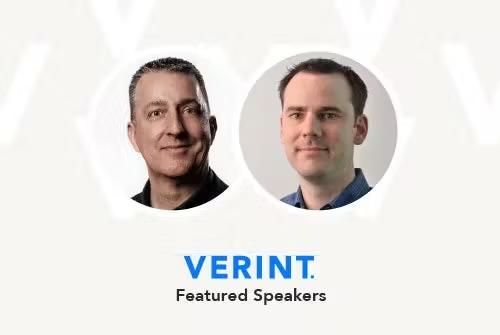
Data Silos Have Got to Go! Breaking Down Data Silos in Customer Engagement


The amount of data created each day is mind blowing. According to Statista, “the total amount of data created, captured, copied, and consumed globally is forecasted to grow from 64.2 zettabytes in 2020 to over 180 zettabytes in 2025.” Zettabytes! To give you some perspective, a megabyte is 1,000,000,000 bytes. A zettabyte is 1,000,000,000,000,000,000,000 bytes!
I share this, not to downplay the volume corporate data scientists and executives currently need to manage, but to make you feel a bit better about your remit. Still, capturing, analyzing and making recommendations based on your company’s engagement and interaction data is still a challenging task—especially if your data is siloed.
In this blog, the third in a series on breaking down silos (blog 1 – functional silos; blog 2 – channel silos), we are going to focus on data silos and what you can do to unleash the power of data trapped in your systems.
Why are data silos bad for your business and difficult to eliminate?
When different customer support functions of a company hold their engagement and interaction data in separate, legacy systems—thereby isolating it from one another—your customer data becomes trapped in silos. These data silos can have multiple negative effects on businesses such as:
- Hindering proper data analysis
- Generating data inconsistencies
- Creating data gaps that prohibit a comprehensive view of the customer journey.
This can result in serious consequences over time, including inefficient time management and increased resource costs.
So, why are businesses still struggling with legacy systems and trapped data? Historically, data consolidation hasn’t been easy. Many decision makers shiver at the thought of doing it for a couple of reasons:
- It can be expensive. There’s no point in blowing smoke about it. Even with the long-term cost and efficiency benefits, the upfront investment needed for data consolidation is sometimes enough to discourage C-levels.
- As is the case with most niche areas in IT, recruiting specialized data professionals poses significant challenges. Data consolidation is a complex task, therefore finding the right SME is difficult.
- It takes time. All organizations have their own data problems stemming from the unique way they work and the different platforms they use so, unfortunately, there’s no ‘one size fits all’ solution. To keep the exercise from becoming overwhelming and seemingly endless, you’ll need a clear strategy to work against and a plan that consolidates the data gradually over time.
The cloud came, saw, and conquered
As daunting as we may have made it sound above, eliminating customer data silos has actually gotten a lot easier in recent years. As part of their digitalization journey, many businesses have moved to the cloud (either fully or adopting what is called a ‘hybrid approach’). In addition to a wealth of benefits moving to the cloud can have for virtually all aspects of running a company—it has put data consolidation into the well-deserved limelight.
Cloud-based databases, also known as data lakes, can store huge amounts of data collected from various sources so they can be retrieved, analyzed, and leveraged for better decision making. For businesses looking to improve their customer service operations and overall customer experience, consolidated engagement and interaction data can be a goldmine of insights.
But to achieve these goals, you need to be able to access your engagement data from across your entire organization—including all communication channels and platforms, as well as customer feedback. This is impossible to achieve if your data is locked away in separate systems.
Unlock the power of your engagement data
When your ability to access and manage engagement data from every channel is no longer hindered by the silos within your company, the possibilities become virtually limitless. Verint Engagement Data Management and Engagement Data Hub (EDH) helps you quickly and easily harmonize, manage, and analyze your engagement data by consolidating it all into one place. Whether the customer data comes from phone calls, digital interactions, or customer feedback, it’s stored safely in the EDH.
Then Verint Engagement Data Management (EDM) can leverage all that information to help power businesses’ intelligence and automation, improve interaction quality and compliance, and elevate customer experience.
What’s more, EDH is not limited to data from Verint systems only. In addition to automatically collecting and storing customer and employee engagement data from any Verint application running on Verint Platform, it can also be connected with external sources.
So, you can further enrich your engagement data and gain even more sophisticated business insights by layering in data from other sources.
Engagement Data Management and the Purpose-built Engagement Data Hub at a Glance:
- Automatic data collection from your Verint applications running in Verint Platform
- Ability to ingest interaction data from external sources and archives
- Harmonizing of diverse data types into a cohesive whole
- Out-of-the-box support for data integration, enrichment, management, and compliance
- Open APIs to integrate to external solutions and export to data lakes and BI tools
- Insights to power your business intelligence, automation, and CX initiatives.
To learn more about EDH, EDM, and how to eliminate data silos, watch the webinar ‘The Engagement Data Hub: What is it and why do you need it?’.
We hope you enjoyed our blog series on breaking down silos. Whether they’re hindering your customer service operations, driving a wedge between your engagement channels, or preventing you from unlocking the power of your engagement data, the time is now to break down these silos.
Consider creating a holistic view of your operations, workforce, channels, and customer journeys to drive efficiencies, create competitive advantages, and deliver an exceptional customer experience.
